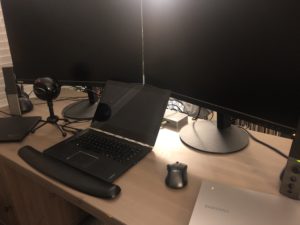 We tend be somewhat hypocritical about time spent online, its value against time in the physical world, and how we value it.
We tend be somewhat hypocritical about time spent online, its value against time in the physical world, and how we value it.For example, there is often fear that if kids, and especially adolescents, spend too much time on computers, phones, or the internet in general that they are being anti-social and are missing out on the value of “real-world” connections. Then, we, as adults, spend an inordinate amount of time staring at screens, monitoring social media, updating our friends, and coordinating real world meet ups.
I can understand why adolescents who spend all day in school and activities with their time controlled by others may want some time to themselves or at least in an environment they control. In some ways, they may have a better balance than us adults who spend all day on screens working, then all evening on screens catching up on social media, watching tv, or playing games.
The internet is a proven tool for community building, discourse (not always of the highest caliber but still…), and sharing ideas. You do not need to look any further than Facebook, Twitter, MeetUp, Discord, Quora, Reddit, and you know I could go on and on.
These days conversations about online community tend towards Web3 or the Metaverse or whatever you want to call. I think that is a long way off. I try to keep these on a single topic so I’ll get into that later but I think we have a lot of milestones to achieve first before we don headsets for every-day life. That’s more a matter of bringing the use case to users rather than expecting people to flock to a virtual reality.
During the pandemic, online communities and tools became much more obvious. A group of my friends who frequently get together live shifted to a large and active Discord server. We still get together but moving a lot of conversation online has made it a lot easier for those of us who have moved to keep up with the day to day banter. Online communities have improved opportunities and possibilities for highly dispersed communities and long distance friendships.
One of my favorite personal examples is through a game. I’ve been playing Marvel Strike Force for years. It is a game where you collect Marvel heroes and build teams to battle the evil that seeks to conquer the universe, yes, I love Marvel and superheroes. Through this game, I’ve made numerous friends but two stand out. These are now friends that I keep up with out of the game. We know about each others kids, hobbies, jobs, the ups and downs of life. I have never met them in real life (although one lives one town over!) but I would count them as friends made possible through an online game. I know I’m not the only one to have had this experience.
There is a balance to be found. Too much of anything can become a bad thing. I’m not advocating for being on a screen 16 hours a day. In fact, the first take away is that we should spend more time not on screens which will, in turn, make our time on screens more valuable and useful. In this sense, let’s learn from the paradigm that we impose on adolescents.
Then, the other takeaway is that we get out of being online what we put in. Behavior is key. Act like you would in physical space and you can have similar experiences online.
Finally, can we come up with a better name for non-virtual or not online space? To call it reality or real life is becoming more and more of a misnomer. The things we do online are real, we have real friendships and transact real activities. Its not unreal or less valuable because its online; in some senses, it may be more valuable, or at least more leveraged.
Used as a way to augment real friendships and real community, the internet and online experiences build real, tangible communities that should not be ignored.
Tagged blockchain, community, internet life, paradigm shift, social